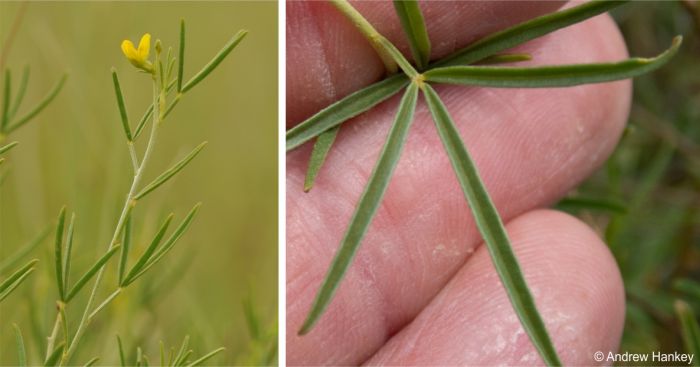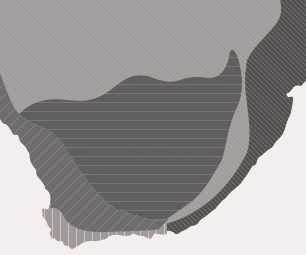Melolobium subspicatum
Melolobium subspicatum Conrath
Family: Fabaceae
Common names: dolomite honey bush (Eng.); kalkheuvel-heuningbossie (Afr.)
Introduction
Melolobium subspicatum is a rare and endangered perennial shrub in the legume family (Fabaceae), endemic to Gauteng, South Africa.

Description
Description
Melolobium subspicatum is a small, bushy shrub reaching about 300–600 mm in height. Its leaves are green, alternately arranged along the stem and trifoliolate, each leaf is composed of three linear (long and narrow) to oblanceolate (rounded apex with a tapering base) leaflets, that have a smooth to slightly hairy surface. The leaves have no stipules. The stem is often covered with short hairs when young, and its base becomes woody as the plant matures, while the upper part remains soft and green. The plant bears bright yellow pea-shaped flowers that age to orange, organized in short, terminal spikes. Blooming primarily takes place from spring to early summer (September to December in South Africa). Its fruit is a slender, linear, hairy pod (legume), that splits open at maturity and typically contains 2–4 hard-coated seeds.

Conservation Status
Status
Melolobium subspicatum is assessed as Vulnerable (VU) on the Red List of South African Plants because it has a limited area of occupancy and is known from only a few locations within Gauteng Province, and has lost most of its habitat to urban development and mining, with only very small areas of suitable habitat remaining that are scattered through the former distribution range. The species is threatened by habitat degradation, and altered fire regimes, where both too frequent or too infrequent fire is causing changes in species dynamics that may affect the health and viability of the remaining populations. It was assessed as Endangered in 2002, but downgraded to Vulnerable in 2005 since the remaining population is stable because no more habitat is being lost where the species still occurs.
Distribution and habitat
Distribution description
Melolobium subspicatum is a rare species that is endemic to South Africa and has an extremely limited distribution in Gauteng Province, within the Highveld region, between Krugersdorp and Pretoria. The species thrives in open grassland with nutrient-poor, well-drained soils, typically on shallow, rocky, or sandy substrates, on dolomite.

Derivation of name and historical aspects
History
Melolobium subspicatum was named by Paul Conrath (1861–1931), an Austrian chemist and naturalist who spent some time in South Africa working for an explosives factory in Modderfontein and made many plant, bird and insect collections in the area in his free time. The genus name is derived from the Greek words melos, meaning jointed and lobos meaning pod or legume. Thus, Melolobium means jointed pod, possibly referring to the joint-like constrictions between the seeds in the fruits. The species name is derived from Latin, sub meaning somewhat or nearly, and spicatum, meaning spikes. The name subspicatum thus means somewhat spiked, likely referencing the short spike-like arrangement of its flowers.
Melolobium belongs in the legume family (Fabaceae) which is the third largest family of flowering plants with approximately 700-770 genera and 18 000-20 000 species worldwide.

Ecology
Ecology
Melolobium subspicatum produces bright yellow to orange flowers that are rich in nectar and attract insect pollinators, especially bees, which are vital for reproduction. The plants likely play a role in maintaining pollinator diversity in their ecosystem, especially during the spring bloom. It reproduces through seeds contained in slender pods, and the seeds are likely dispersed mechanically by the pod splitting open and expelling the seeds when mature.
This species is a resprouter, the above-ground parts of the plant are burned during a fire but the plant survives and produces new shoots after the fire. This is an adaptation to its grassland habitat which frequently experiences fires. It also flowers most profusely after a fire.

Uses
Use
There are no documented traditional uses of Melolobium subspicatum. However, extracts from this species contain higher levels of alkaloids than those of other related species in the Melolobium genus. Some related species, such as M. alpinum, M. candicans and M. microphyllum, are known in southern Africa for their traditional medicinal applications. Many legume species in African regions frequently contain bioactive compounds like flavonoids, alkaloids, and tannins, which have long been used in traditional medicine.

Growing Melolobium subspicatum
Grow
Melolobium subspicatum is threatened in the wild and not commonly cultivated. It can be successfully propagated and grown under controlled or natural conditions. Seed propagation is the most reliable method. Collect seeds from mature pods in late summer or autumn. The seeds are hard-coated and germinate better after pre-treatment. Scarify the seeds before planting to improve germination, either by lightly cutting the seed coat with a blade or by soaking the seeds in warm water for 12-24 hours. Sow seeds in a well-draining seedling mix, such as sand mixed with compost or loam, planting them about 1 cm deep. Keep the seed tray moist but not waterlogged and place it in a warm environment. Germination typically occurs within 2-3 weeks. Transplant seedlings once they have well-developed roots.
Melolobium subspicatum can also be propagated through stem cuttings, although this method is less reliable. Take semi-hardwood cuttings in late spring or early summer. Apply rooting hormone to stimulate root growth and place the cuttings in a well-draining propagation mix. Keep the medium moist and maintain high humidity (e.g., in a mist house or under plastic) until roots form.
References
- Bester, S.P. 2021. Observation of Melolobium subspicatum, Pretoria, Gauteng. iNaturalist. Online. https://www.inaturalist.org/observations/99895985
- Glen, H.F. & Germishuizen, G. (compilers). 2010. Botanical exploration of southern Africa, edition 2. Strelitzia 26. South African National Biodiversity Institute, Pretoria.
- Hankey, A. 2025-Jul. Observations of Melolobium subspicatum. iNaturalist. Online. https://www.inaturalist.org/observations?taxon_id=440375&user_id=andrew_hankey.
- Jackson, W.P.U. 1990. Origins and meanings of names of South African plant genera. University of Cape Town Printing Department, Cape Town.
- Krige, A. & Van Wyk, B. 2005. The mystery of the silver vegetation. Veld & Flora 91(3):134-137.
- Moteetee, A. & Van Wyk, B.-E. 2006. A revision of the genus Melolobium (Genisteae, Fabaceae). South African Journal of Botany 72:51-98.
- Moteetee, A., Moffett, R.O. & Sleteng-Kose, L. 2019. A review of the ethnobotany of the Basutho of Lesotho and the Free State Province of South Africa (South Sotho). South African Journal of Botany 122:21-56.
- Nenungwi, L. 2024. Melolobium candicans (E.Mey.) Eckl. & Zeyh. (Fabaceae). PlantZAfrica. Online. http://pza.sanbi.org/melolobium-candicans.
- Richard Gill 2021-Dec. Observation of Melolobium subspicatum, Pretoria rural, Gauteng. iNaturalist. Online. https://www.inaturalist.org/observations/102765295.
- SAplants. Photographs of Melolobium subspicatum, Kalkheuvel West, Gauteng. Wikimedia Commons. https://commons.wikimedia.org/wiki/Category:Photographs_by_SAplants. Accessed 30 Jul 25.
- Van Wyk. B.E., Verdoorn, H.G., Burger, L. & Grienwald, R. 1988. The major alkaloids of the genus Melolobium. South African Journal of Botany 54(4):386-388.
- Victor, J.E & Pfab, M.F. 2005. Melolobium subspicatum Conrath. National Assessment: Red List of South African Plants. https://redlist.sanbi.org/species.php?species=282-20.
- Wikipedia. Melolobium. https://en.wikipedia.org/wiki/Melolobium. Accessed on 2 July 2025.
Credits
Accurate Sondlhana and Lesego Tlhatlhelang
Free State National Botanical Garden
and Alice Notten, Kirstenbosch National Botanical Garden
August 2025
Acknowledgements: images by Andrew Hankey, Pieter Bester, Richard Gill and SAplants from their observations posted on the internet.
Plant Attributes:
Plant Type: Shrub
SA Distribution: Gauteng
Soil type: Sandy, Metal-rich
Flowering season: Spring, Early Summer
PH: Acid
Flower colour: Yellow
Aspect: Full Sun
Gardening skill: Challenging
Special Features:
Horticultural zones








Rate this article
Article well written and informative
Rate this plant
Is this an interesting plant?
Login to add your Comment
Back to topNot registered yet? Click here to register.